8.6 Transfers without Mechanical Assistive Devices
Types of Client Transfers: Transfers without Mechanical Assistive Devices
Client Transfer from Bed to Stretcher
A bed to stretcher transfer requires a minimum of three to four people, depending on the size of the client and the size and strength of the health care providers. Clients who require this type of transfer are generally immobile or acutely ill, so they may be unable to assist with the transfer. Checklist and Table 8.6.1 shows the steps for moving clients laterally from one surface to another.
Checklist 8.6.1: Moving a Client from Bed to Stretcher
Disclaimer: Always review and follow your agency policy regarding this specific skill.
Safety considerations:
- Check room for additional precautions.
- Introduce yourself to client.
- Listen and attend to client cues.
- Ensure client’s privacy and dignity.
- Complete the point-of-care risk assessment for safer client handling.
- Inform the client what is about to happen and how they can assist.
- Ensure tubes and attachments are properly placed prior to the procedure to prevent accidental removal.
- Ensure brakes are locked on the bed and stretcher.
- A slider board and full-size sheet or friction-reducing sheet are required for the transfer.
| STEP | ACTION | ADDITIONAL INFORMATION |
|---|---|---|
| 1. | Perform hand hygiene | |
| 2. | Always predetermine the number of staff required to safely transfer a client horizontally. | Three to four health care providers are required for the transfer. |
| 3. | Introduce yourself. Explain what will happen and how the client can help (tucked-in chin, keep hands on chest).
Collect supplies. |
This step provides the client with an opportunity to ask questions and help with the transfer.
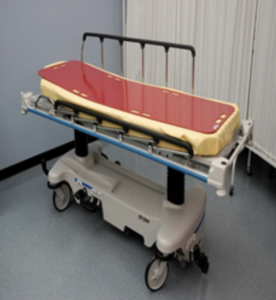  |
| 4. | Raise bed to safe working height. Flatten the head of bed and side rails.
Position the client closest to the side of the bed where the stretcher will be placed. |
Safe working height is at waist level of the shortest health care provider.
The client must be positioned correctly prior to the transfer to avoid straining and reaching. May need additional health care providers to move client to the side of the bed. |
| 5. | Position stretcher beside the bed on the side closest to the client with stretcher slightly lower. Apply brakes.
Caregiver #1 stands closest to the client. Caregivers #2 and #3 stand on the other side of the bed: #2 is at the head and shoulders, and #3 is at the hips and legs. Caregiver #4 can be used to move feet or equipment or help #2 and #3 with pulling. |
The slider board will form a bridge between the bed and the stretcher.
The sheet must be between the client and the slider board to decrease friction between client and board.  Ensure all tubes and attachments are out of the way. |
| 6. | Caregiver #1 uses a front-to-back weight shift to roll client onto their side using the sliding sheet.
Meanwhile, caregivers #2 and #3 climb onto and kneel on the bed to place the slider board halfway under the client. The client is returned to the supine position. Client’s feet are positioned on the slider board. |
Ensure proper body mechanics by keeping elbows close and backs tall.
The position of the health care providers keeps the heaviest part of the client near the health care providers’ centre of gravity for stability.  |
| 7. | Caregivers #2 and #3 can remain on the stretcher. They grasp the draw sheet using a palms up technique, sitting-up tall, and keeping their elbows close to their body and backs straight.
Caregiver #1 remains on the far side of the bed, between the chest and hips of the client, with hands on hips and shoulders and forearms parallel to the bed. |
Alternately, caregivers #2 and #3 can stand on the floor opposite to caregiver #1, grab the draw sheet using a palms up technique, and a front-to-back weight shift position. |
| 8. | The designated leader will count “1, 2, 3,” and start the move.
Caregiver #1 will push client just to arm’s length using a back-to-front weight shift. At the same time, caregivers #2 and #3 on the stretcher will move from a sitting-up-tall position to sitting on their heels, shifting their weight from the front leg to the back, bringing the client with them using the sheet. |
Coordinating the move between health care providers prevents injury while transferring clients.
Using a weight shift from front-to-back uses the legs to minimize effort when moving a client. |
| 9. | Caregivers #2 and #3 will climb off the stretcher and stand at the side, and grasp the sheet keeping elbows tucked-in.
On the count of three, with backs straight and knees bent, they use a front-to-back weight shift and slide the client into the middle of the bed. |
The step allows the client to be properly positioned in the bed and prevents back injury to health care providers.
 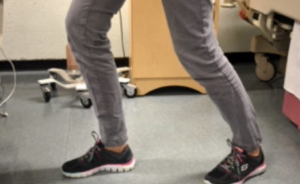 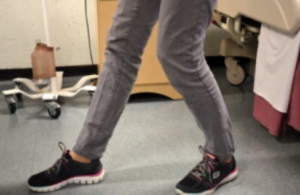 |
| 10. | At the same time, caregiver #1 pulls the slider board out from under the client. | This step allows the client to lie flat on the bed. |
| 11. | Replace pillow under head, ensure client is comfortable, and cover the client with sheets. | This promotes comfort and prevents harm to client. |
| 12. | Lower bed. Raise side rails as required, and ensure call bell is within reach.
Perform hand hygiene. |
Placing bed and side rails in a safe position reduces the likelihood of injury to client. Proper placement of call bell facilitates client’s ability to ask for assistance.
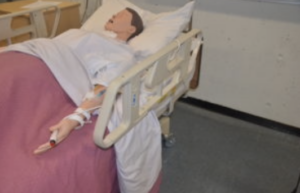 Hand hygiene reduces the spread of microorganisms. |
For more information on sliding board transfers, sign up to take the 10-minute Provincial Health Authority course: Lateral Transfer Sliding Board – LearningHub (phsa.ca)
Transfer from Bed to Wheelchair
Clients often need assistance when moving from a bed to a wheelchair. A client must be cooperative and predictable, and able to bear weight on both legs and take small steps. If any of these criteria are not met, a two-person transfer or mechanical lift is recommended. Always complete the point-of-care risk assessment prior to all client-handling activities. See Checklist and Table 8.6.2 for the steps to transfer a client from the bed to the wheelchair (PHSA, 2010).
Checklist 8.6.2: Bed to Wheelchair Transfer—One Person Assist
Disclaimer: Always review and follow your agency policy regarding this specific skill.
Safety considerations:
- Check the room for additional precautions.
- Listen and attend to client cues.
- Ensure client’s privacy and dignity.
- Complete the point-of-care risk assessment for safer client handling.
- Inform the client what is about to happen and how they can assist.
- Ensure tubes and attachments are properly placed prior to the procedure to prevent accidental removal.
- Ensure brakes are locked on the bed and stretcher.
- A gait belt and wheelchair are required.
| STEP | ACTION | ADDITIONAL INFORMATION |
|---|---|---|
| 1. | Perform hand hygiene. | |
| 2, | Introduce yourself. Explain what will happen during the transfer and how the client can help. | This step provides the client with an opportunity to ask questions and help with the positioning.
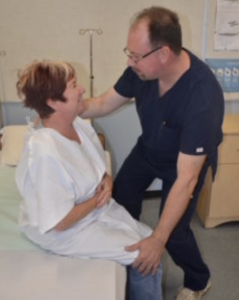 |
| 3. | Apply proper footwear prior to ambulation. |
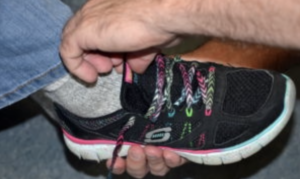 |
| 4. | Lower the bed and ensure that brakes are applied.
Place the wheelchair next to the bed at a 45-degree angle and apply brakes. If a client has weakness on one side, place the wheelchair on the stronger side. |
Ensure brakes are applied on the wheelchair.
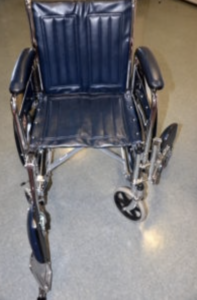 |
| 5. | Sit the client on the side of the bed with their feet on the floor. Apply the gait belt snugly around the waist (if required).
Place hands on waist to assist into a standing position. |
The client’s feet should be in between the health care provider’s feet. |
| 6. | As the client leans forward, grasp the gait belt (if required) on the side of the client, with your arms outside the client’s arms. Position your legs on the outside of the client’s legs.
The client’s feet should be flat on the floor. |
 |
| 7. | Count to three and, using a rocking motion, help the client stand by shifting weight from the front foot to the back foot, keeping elbows in and back straight. |
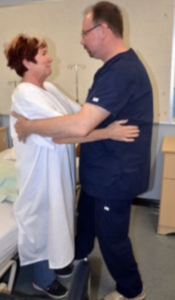 |
| 8. | Once standing, have the client take a few steps to the side and back until they can feel the wheelchair on the back of their legs.
Have client grasp the arm of the wheelchair and lean forward slightly. |
Ensure the client can feel the wheelchair on the back of the legs prior to sitting down.
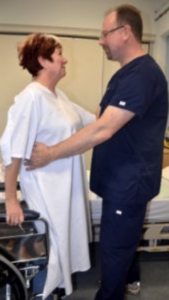 |
| 9. | As the client sits down, shift your weight from back to front with bent knees, with trunk straight and elbows slightly bent.
Allow client to sit in wheelchair slowly, using armrests for support. |
This allows the client to be properly positioned in the chair and prevents back injury to health care providers.
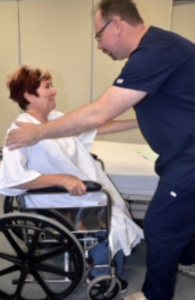 |
Special considerations:
- Do not allow clients to place their arms around your neck. Have them place their arms around your hips.
- Avoid lifting clients. Let them stand using their own strength.
- Stay close to your client during the transfer to keep the client’s weight close to your centre of gravity.
- If the client has weakness on one side of the body (e.g., due to a cerebral vascular accident [CVA] or stroke), place the wheelchair on the stronger side.
Update
Some health authorities are no longer recommending the caregiver be positioned directly in front of the client being transferred. Instead, the caregiver should stand to the side of the client and use a gait/transfer belt to guide the client.
Watch the video produced by Thompson Rivers University – School of Nursing on how to assist a client from a bed to chair with a gait belt.
Assisting from Bed to Chair with a Gait Belt or Transfer Belt (2018) by Kim Morris of Thompson Rivers University School of Nursing.
Critical Thinking Exercises
- Prior to moving the client from bed to a wheelchair, where should the client’s feet be placed?
- Data sources: Perry et al., 2018; PHSA, 2010. Images retrieved from 3.7 Patient Transfers in Clinical Procedures for Safer Patient Care by Glynda Rees Doyle and Jodie Anita McCutcheon, CC BY 4.0 ↵
- Data sources: Perry et al., 2018; PHSA, 2010. Images retrieved from 3.7 Patient Transfers in Clinical Procedures for Safer Patient Care by Glynda Rees Doyle and Jodie Anita McCutcheon, CC BY 4.0 ↵
The point in the body in which weight is evenly distributed or balanced on either side.

